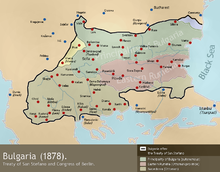
Back Вызваленне Балгарыі Byelorussian Освобождение на България Bulgarian Osvobození Bulharska Czech Liberación de Bulgaria Spanish Libération de la Bulgarie French Liberazione della Bulgaria Italian Libertação da Bulgária Portuguese Освобождение Болгарии Russian Çlirimi i Bullgarisë Albanian Ослобођење Бугарске Serbian

The Liberation of Bulgaria is the historical process as a result of the Bulgarian Revival. In Bulgarian historiography, the liberation of Bulgaria refers to those events of the Tenth Russo-Turkish War (1877–1878) that led to the re-establishment of the Bulgarian state under the Treaty of San Stefano of 3 March 1878.
The treaty forced the Ottoman Empire to give back to Bulgaria most of its territory conquered in 14th century. At the Berlin Congress of the same year, the Treaty of Berlin was adopted, according to which the territories of the Bulgarian state, as established by the San Stefano treaty, were divided into three parts. The first part was the Principality of Bulgaria, which functioned independently but was nominally a vassal of the Ottoman Empire and was limited to Moesia and areas adjacent to the capital, Sofia.
The second part was to be an autonomous province of the Ottoman Empire—Eastern Rumelia. The third and largest part—all of Macedonia and Lozengrad—were restored to the Ottoman Empire, while some outlands were assigned to Serbia and Romania. Those territories seized from Bulgaria after the Congress of Berlin, including most of Macedonia, Thrace, and others, had a majority ethnic Bulgarian population.
On 6 September 1885, Eastern Rumelia became part of the Principality of Bulgaria after a bloodless unification. Although the principality was a de facto independent nation, it was de jure a vassal of the Ottoman Empire until 1908, when Bulgaria proclaimed its independence.
The 1908 declaration, which signified Bulgaria's break with Ottoman rule, was actually the second liberation of Bulgaria. After the conquest of the First Bulgarian Empire in 1018, the first liberation of Bulgaria led to the establishment of the Second Bulgarian Empire in the aftermath of the Uprising of Ivan Asen I of Bulgaria and his brother Theodor (Peter) against the Byzantine Empire on 3 March 1185.